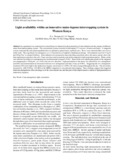| dc.contributor.author | Woomer, PL | |
| dc.contributor.author | Tungani, JO | |
| dc.date.accessioned | 2015-06-20T11:58:52Z | |
| dc.date.available | 2015-06-20T11:58:52Z | |
| dc.date.issued | 2003 | |
| dc.identifier.citation | African Crop Science Conference Proceedings, Vol. 6. 42-46, 2003 | en_US |
| dc.identifier.uri | http://hdl.handle.net/11295/85296 | |
| dc.description.abstract | An experiment was conducted in western Kenya to characterize the penetration of solar radiation into the canopy of different
maize-bean intercropping systems. The conventional system consisted of alternating 37.5 cm rows of maize and beans. A staggered
system contained the same plant population but was planted as paired maize and bean rows. Rows were oriented either east-west or
north-south. The experiment was arranged as a 2 x 2 factorial in a Completely Randomized design. All treatments received 31 kg N
and 20 kg P ha-1 as mineral fertilizer. Solar radiation was measured at maize tasseling at positions above the maize canopy, above the
bean understorey and above the soil. Crops were harvested at maturity and yield compared to light penetration patters. Maize yields
were affected by neither row arrangement nor orientation and averaged 4.9 t ha-1. Bean yields were significantly greater in the staggered
row arrangement (+320 kg ha-1, p = 0.021) but not row direction. Light penetration to the beans was affected by row arrangement
(p<0.001) and demonstrated an interaction between row arrangement and time of day (p<0.001). Staggering the row arrangement
resulted in 20% more light to the understorey legume, an increase of 11500 LUX when averaged throughout the day. The net returns
increased by KSh 5356 ha-1 (US $69) in the MBILI compared to conventional intercropping. These findings suggest that staggered
intercrop arrangements offer advantage over the conventional one and that part of that improvement is related to light penetration to
understorey legumes. | en_US |
| dc.language.iso | en | en_US |
| dc.subject | Crop management | en_US |
| dc.subject | Light | en_US |
| dc.subject | Orientation | en_US |
| dc.title | Light availability within an innovative maize-legume intercropping system in Western Kenya | en_US |
| dc.type | Article | en_US |
| dc.type.material | en_US | en_US |

